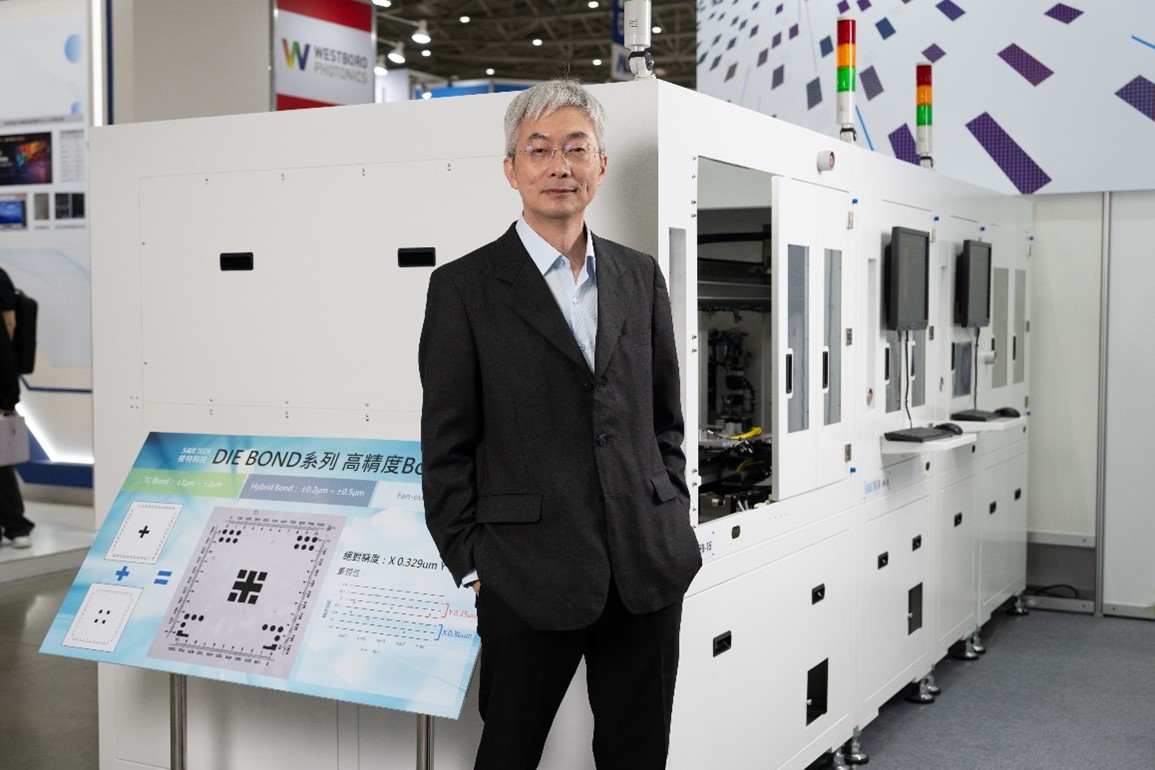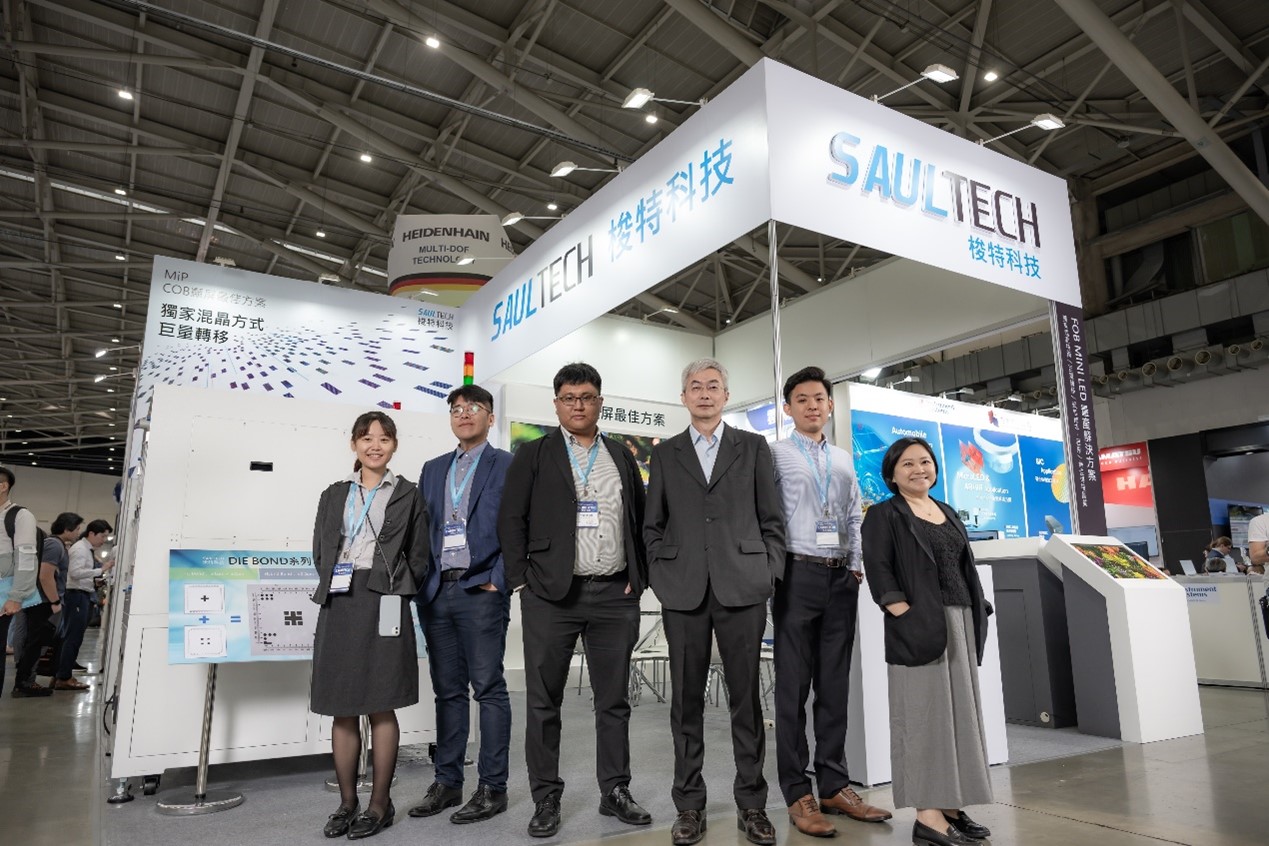
When Saultech was founded in 2010, it quickly gained recognition in the industry with its LED mapping sorters. Today, the film-on-board (FOB) solution for direct-view Mini LED displays has become one of the company’s three main focuses for future development. The originally promising hybrid bonding faced delays due to technical issues in the front- and back-end processes. Nevertheless, the company has promptly reallocated resources flexibly to TC bond and micro bonding technologies, along with fan-out mass transfer pick-and-place, marking a new breakthrough for Saultech in transitioning to the advanced semiconductor packaging equipment market.
Since its establishment, Saultech has excelled in the pick-and-place technology and made a name for itself in the industry with LED mapping sorters. Having installed more than 15,000 machines in China, Saultech supplies mapping sorters to major clients such as Epistar, San’an Optoelectronics, and HC Semitek, securing a market share of nearly 90%. The company has truly established itself as a leading player in this field.
Evolution of LED Mapping Sorters: Saultech Offers Optimal Solution for Mini LED Displays with the Self-developed FOB Process
Lu Yan-Hao, General Manager and CTO at Saultech, revealed that the company has constantly been developing its business in other LED fields in addition to the LED sorter sector. The equipment provider will also prioritize its self-developed film-on-board (FOB) packaging technology, poised to replace conventional COB (chip-on-board) packaging. This innovative technology is expected to become the optimal solution for mass producing direct-view Mini LED displays, offering high yields at a lower cost.
In conventional COB packaging processes, apart from the front-end sorting machine, the die bonder plays the most critical role before reflow soldering. However, the die bonder is completely excluded from the FOB process, said Lu. This is because the current sorter’s output (UPH) exceeds 40-60K/H, with an accuracy of +-10µm, which is comparable to or even better than that of the die bonder. Moreover, the sorter’s color mixing function is easier to operate than that of the die bonder. More importantly, Saultech has made a breakthrough by transforming the sorter’s bin into a carrier for mass transfer, making it a key machine for mass transfer and the pre-reflow process.
Harnessing FOB Technology: Saultech Dives into Mini LED on One Side, MiP on the Other
The FOB process comprises four steps. First, Saultech’s three-in-one (sorting, mixing, and arrangement) machine ST-668 performs LED chip sorting, mixing, and arrangement and accurately transfer the chips to a specialized film based on the optimal result of color mixing computation. Notably, the ST-668 combines the sorter, color mixer, and die bonder into just one single device. Next, the company’s FB-20 transfers the LEDs to the client’s PCB, whereby mass transfer replaces conventional die bonding, offering a simplified process at a lower cost.
Unlike the COB process, the FOB process does not divide RGB chips into different bins, but instead combines them into a central bin with a consistent wavelength. Lu emphasized that through a special hybrid binning technique, it is possible to maintain consistent color coordinates between different production lots, enabling low inventory without color deviation, along with 0.2-nm accuracy. The company’s patented sorting-and-mixing method can achieve a more uniform color effect than conventional die mixing, addressing the long-standing challenges in repair and material preparation of direct-view panels in the industry.
The second step involves a thorough automated optical inspection (AOI) using the RT-668 repair machine. If any defects are found, they are repaired through the chip removal and refill process. This machine performs repair first on a special mold before reflow soldering, achieving the highest first past yield to ensure quality. In contrast, the COB process conducts defect inspection and rework after reflow, making it more challenging with lower quality control.
The third and fourth steps involve mass transfer and reflow soldering, respectively. The FB-20 mass transfer automatic alignment and soldering machine aligns and bonds the PCB display substrate with the pre-arranged LED chips. After heating, the die bonding process is completed. These two steps not only ensure high flatness of the LED chips on the substrate and minimal color deviation at low angles but can also come with a short operation time. This can greatly improve the issue of flux or solder paste drying out due to long waiting times.
The FOB mass transfer technology can easily overcome challenges such as different chips, varying amounts of solder paste, or substrate warpage. Moreover, this technology enables the full utilization of all good chips on the wafer, avoiding unnecessary waste and significantly reducing production costs.
While Lu held a conservative attitude towards Micro LED, he now sees the advantages of the MiP (Micro LED in package) technology in terms of better solder reliability, yield, lifespan, chip flatness, and light emission distribution. With the successful implementation of the said proprietary three-in-one and hybrid binning techniques, Saultech not only resolves the issue of inconsistent chromaticity and brightness between different lots of Micro LEDs after die mixing but also achieves perfect color accuracy without deviation. The four steps of the FOB process can also be applied to direct-view MiP applications, making FOB the optimal solution for achieving 100% yield in mass producing MiP displays.
Saultech Flexibly Changes Its Strategies by Integrating Resources for Hybrid Bonding and Micro Bonding
Since 2014, Saultech has been firmly established in the semiconductor equipment field with its advanced pick-and-place technology. The company specializes in 12-inch wafer sorters and pre-arrangement mass transfer equipment for processes such as wafer-level chip scale packaging (WLCSP), fan-out wafer-level packaging (FOWLP), and fan-out panel-level packaging (FOPLP), all of which have achieved good sales performance in the market.
In recent years, Saultech has actively transformed its focus, with a primary goal being hybrid bonding technology, one of the trending technologies in advanced semiconductor packaging. Lu stated that with the increasing demand for AI chips, 3D advanced packaging has become a crucial technology. In the post-Moore’s Law era, the emphasis is no longer on shrinking chip sizes but on solving and enhancing energy efficiency per watt of computing power and improving data transfer efficiency between chips. In addition to the emerging Silicon Photonics technology (co-packaged optics [CPO]), hybrid bonding, which offers advantages such as ultra-fine pitch, ultra-small spacing, and zero-thickness solder balls, has become a key technology for major CPU, GPU, AI chip, and memory chip manufacturers to address the said issues.
Since collaborating with the Industrial Technology Research Institute (ITRI) in 2021, Saultech has invested in developing hybrid bonding technology in the last three years, resulting in over 20 related patents covering breakthroughs in alignment methods, bonding waves, and six-sided cleaning techniques. Precision has been a major challenge in hybrid bonding, but the company’s patented invention has achieved a precision of 0.2 μm, effectively solving this issue. In 2022, the company introduced the DB-20 nanoscale ultra-high precision hybrid bonder, with plans to launch the third-generation device this year.
Currently, Saultech has entered into hybrid bonding and fan-out technology cooperation agreements with world-class integrated circuit manufacturers and package providers in Taiwan. While details of the collaborations are confidential due to non-disclosure agreements, working with industry-leading partners to drive technological breakthroughs positions Saultech as a semiconductor equipment manufacturer with proprietary technology in the advanced packaging field. Additionally, Lu mentioned that the company is also involved in the research and development of gang bonding. Since four years ago, Saultech’s gang bonder has had significant sales in China, with substantial orders this year.
It is worth noting that due to the significant and complex technical challenges that hybrid bonding entails, as well as the high difficulty for customers to adopt it—plus a high cost—Saultech urgently adjusted its strategy at the end of last year. It temporarily postponed related developments and reallocated resources to equipment related to TC bond and micro bonding applications. It is possible that the Saultech’s new TC and micro bonders will be more often seen in the industry, marking a breakthrough in its journey of transitioning to advanced packaging, leading to another peak in revenue.

(Lead image: Lu Yan-Hao, General Manager and CTO at Saultech; photo credit: TechNews)
TrendForce 2023 Micro LED Market Trend and Technology Cost Analysis
Release Date: 31 May / 30 November 2023
Language: Traditional Chinese / English
Format: PDF
Page: 160 / Year
TrendForce 2024 New Mini LED BLU Display Trend Analysis
Release Date: 31 October 2023
Language: Traditional Chinese / English
Format: PDF
Page: 153
|
If you would like to know more details , please contact:
|













